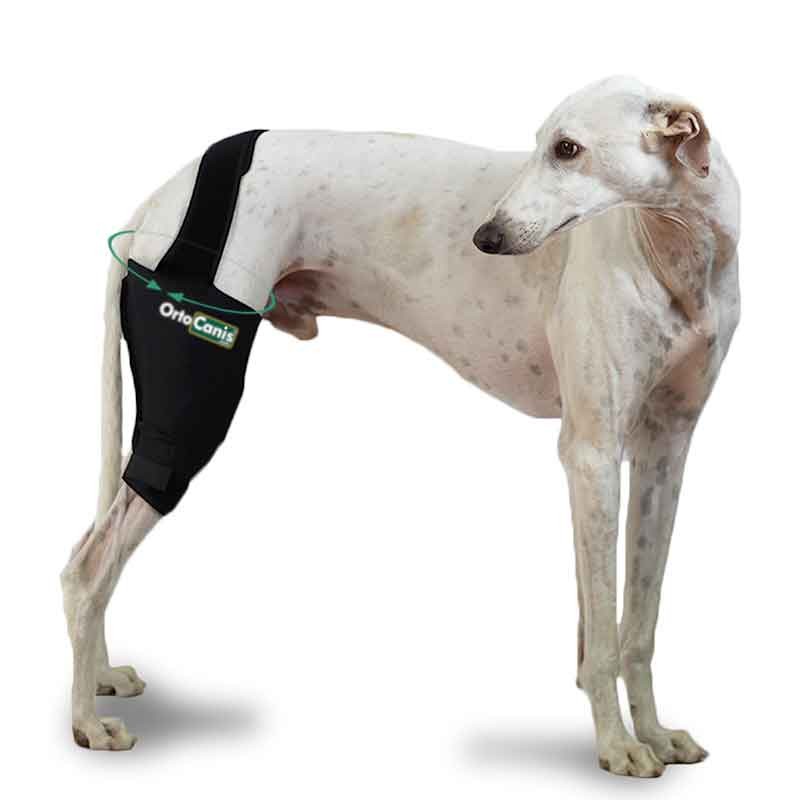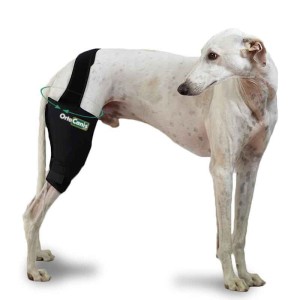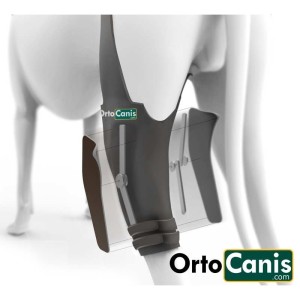At Ortocanis we work to improve the lives of dogs with mobility problems, that includes dogs with some permanent physical disability as well as dogs that need rehabilitation. Marta Subirats, our collaborator, tells you about the rupture of the anterior cruciate ligament.
Of the four ligaments that make up the dog’s knee, rupture of the anterior cruciate ligament is one of the most common pathologies and the most frequent cause of secondary degenerative osteoarthritis in the knee joint. The functions of the cranial cruciate ligament are to limit internal rotation of the tibia and cranial displacement of the tibia relative to the femur and to prevent hyperextension of the knee.
If your dog appears with an acute limp, does not want to put his paw on the ground, or seems to take a few steps and shrinks it, and his knee swells, it is possible that his anterior cruciate ligament is affected.
There is a predisposition in certain dogs to suffer this injury. On the one hand we find small-medium sized dogs (breed or not) with short legs and generally overweight and, on the other hand, large and giant breeds that, due to their morphology, have a tendency to suffer injuries to their ligaments. Among the latter we find the Labrador, Rottweiler, Neapolitan Mastiff, Boxer, etc. In any case, this is not a rule and any dog can have a ligament injury throughout his life.
Apart from the breeds mentioned, there are other factors such as being overweight, sedentary lifestyle, endocrine disorders, sports dogs that do not warm up properly, stairs, sudden climbs to the sofa or the car, or activities that subject the ligaments to micro-trauma and that finally end up damaging them with partial damage or total breakage.
There are two types of treatment, conservative and surgical, whether one or the other is chosen, the animal must carry out a correct recovery of that knee so that it becomes functional again and thus avoid recurrences.
The goals of recovery are to decrease pain, swelling, and lameness, to regain full mobility, muscle mass and strength, and control over the joint.
Physiotherapy varies depending on the animal and the type of treatment, conservative or surgical and, in the case of surgery, the type of intervention. There are surgeries that require more rest and stabilization than others. The recovery process is considered complete when the animal is able to perform daily activities and its knee is able to receive loads and movement without risk of re-injury.
It is important that your pet receives rehabilitation treatment by trained professionals who will choose the best techniques for a quick and effective recovery. Among the most used therapies to treat a crusader problem we find: massages, mobilizations, therapy with currents, ultrasounds, laser, aquatic therapy, balance and coordination training therapy.
During the recovery period it is important that:
– Take your pet on a leash during walks and avoid sudden departures towards other dogs and changes of pace, especially at the beginning of recovery. Your veterinarian or therapist will modify the intensity of the activity as the recovery period progresses.
– Keep the dog off slippery floors. A common cause is recurrence of the ligament tear accompanied by medial meniscus injury.
– Avoid ramps and stairs at the beginning of treatment in operated animals and in animals undergoing conservative treatment. Once rehabilitated, ramps can be used to help get on the sofa and in the car, since it is recommended that they do not do it alone, there could be a recurrence.
– It is recommended that they rest on soft and clean surfaces, but that they are firm enough to help the incorporation of the animal special mattress for dogs
– Keep the skin clean and dry.
– Correct diet and weight control. Being overweight harms the joints and generates more pain for the animal
During recovery or in those animals in which knee instability may arise, the use of a hinged knee orthosis can benefit you and prevent recurrence or possible complications.
Knee orthoses can be used in cases where surgery is not possible or there is some impediment to perform it. These splints, designed exclusively for knee problems, allow progressively increasing degrees of flexion-extension while limiting unwanted movements, providing stability throughout the recovery.
Marta Subirats
Ortocanis physiotherapy technique



